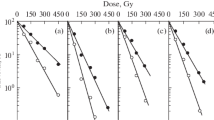Summary
It is reported on experiments with the Rous-sarcoma and the Shopepapilloma. The agent of the Rous-sarcoma can bei inactivated by the SH-blocker p-Chloromercuribenzoic acid. This inactivation proved to be largely reversible by a overplus of Cysteine as SH-donator.
Thereby was showed, that the agent of Rous-sarcoma contains free SH-groups. By the reactivation with Cysteine was proved, that in this loss of activity does not lie before a toxic denaturation by the p-Chloromercuribenzoic acid, but the place of attack are the free Sh-groups.
The completeness of the loss of activity shows, that these free SH-groups are necessary for formation of tumor.
These resultates tend to show further, that the free SH-groups play a important role in the intracellular binding of the agent. The inactivation of the Rous-agent by oxidation may attack at least in part, if not even exclusively in the free SH-groups.
For the virus of Shope-papilloma could not be proved by the employed method free, for activity needed SH-groups.
Similar content being viewed by others
Literatur
Lohmann, K., u. Ferd. Schmidt: Über die Sauerstoffempfindlichkeit und Beständigkeit des leukämieerzeugenden Induktors aus Ehrlich-Ca-Filtraten. Naturwiss. 43, 20 (1956).
Mueller, J. H.: The effect of oxidation of filtrates of a chicken sarcoma (chicken tumor I-Rous). J. of Exper. Med. 48, 343 (1928).
Gye, W. E., and W. J. Purdy: The Rous sarcoma. I. Loss of filtrate activity at incubator temperature: Protection by means of hydrocyanic acid. Brit. J. Exper. Path. 11, 282 (1930).
Pirie, A., and B. E. Holmes: The cause of inactivation of the Rous sarcoma filtrate during incubation. Brit. J. Exper. Path. 12, 127 (1931).
Teti, M., e G. Graziani: Azione di alcuni gas sul virus del sarcoma di Rous. Riv. Pat. sper. 27, 35 (1941).
Suzue, K.: On the dried material of chicken sarcoma. Trans. Jap. Path. Soc. 17, 503, 609 (1929).
Engelbreth-Holm, J., a O. Frederiksen: Reactivation of the fowl-leukosis agent after inactivation by oxydization. Acta path. scand. (Københ.) Suppl. 37, 138 (1938).
Rondoni, P., e G. Boretti: SH-groups and chemical carcinogenesis. Tumori 21, 274 (1947).
Calcutt, G.: 3:4-Benzpyrene as an SH- inhibitor. Brit. J. Canc. 3, 306 (1949).
Potter, V. R.: The inhibition of sulfhydrylcontaining enzymes by split products of p-dimethylaminoazobenzene. Cancer Res. 2, 688 (1942).
Barron, G. E.: The importance of sulfhydryl groups in biology and medicine. Texas Rep. Biol. a. Med. 2/4, 653 (1953).
Bergolts, V. M.: The significance of sulphur-bearing compounds in cancerogenesis. A neuroenzymatic hypothesis of blastomatous growth. Sovr. Biol. 39, 47 (1955).
Maver, M. E., and J. W. Thompson: Sulfhydryl groups in the cathepsin of rat lymphosarcoma. J. Nat. Canc. Inst. 6, 355 (1945/46).
Barron, G. E., and T. P. Singer: Enzyme systems containing active sulfhydryl groups. The role of glutathione. Science (Science, Pa.) 97, 356 (1943).
Stricks, W., I. M. Kolthoff, D. G. Bush and P. K. Kuroda: Experimental study of the polarographic cancer test and of the sulfhydryl titration for the differentiation between normal, cancerous and other pathological sera. J. Lancet 73, 328 (1953).
Carr, J. L.: Regression immunity to Jensen's sarcoma after cysteine injection. Proc. Soc. Exper. Biol. a Med. 35, 343 (1936).
Brunschwig, A., J. Arnold and J. Edgcomb: Stimulation and retardation of neoplastic growth by sulfhydryl compounds. Cancer Res. 6, 560 (1946).
Kennaway, E. L., and I. Hieger: Quantitative studies of the nitroprusside reaction in normal tissues and tumours. Biochemic. J. 21, 751 (1927).
Kertész, D.: Inaktivierung des Rous-Virus durch Polyphenoloxydasesystem (Tyrosinase). Tumori 37, 580 (1951).
Author information
Authors and Affiliations
Rights and permissions
About this article
Cite this article
Schmidt, F. Über die Bedeutung der freien SH-Gruppen für die Aktivität des Agens des Rous-Sarkoms und des Shope-Papillom-Virus. Z Krebs-forsch 61, 527–533 (1957). https://doi.org/10.1007/BF00524629
Received:
Issue Date:
DOI: https://doi.org/10.1007/BF00524629



